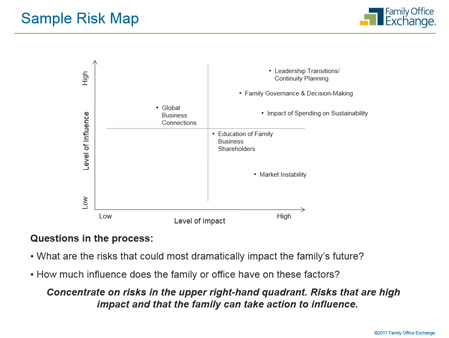What Keeps You Awake at Night? And What Are You Doing About It?

Writing down what’s worrying you releases energy and frees up brainpower to be used more productively. Researchers have found that students with test anxiety who spend 10 minutes journaling before an exam score better than those who carry their worry into the exam. Similarly, studies have shown that writing down your concerns before going to bed can lead to a better night’s sleep. Bottom line: articulating what is keeping you awake at night is the first and most important step to mitigating your concerns.
I have had the chance to participate in many of our 10 FOX Councils, small groups of like-minded wealth owners and family office executives that we bring together twice a year for 1.5 days of peer exchange and education, and have learned a lot about what is keeping these members awake at night by asking them to complete a simple risk map to inventory and prioritize the risks facing their families and family offices.
You may be surprised to learn that family issues top the list of things that keep them awake at night. Whether we were meeting with family members who run their operating companies, CEOs who run sophisticated family offices or the CFOs who manage complex recordkeeping and reporting, the family issues - things like governance and decision-making, succession and preparing the next generation for leadership – show up just as often as the very real financial, business, cyber security and macroeconomic risks.
FOX has been studying the topic of risk with its Thought Leader Council since 2004. This research began with the recognition that one of the most important roles of the family office is that of risk manager, and that risk in the context of a multi-generational family is much broader than insurance and investment risk. With input from family offices and leading industry advisors FOX developed a Risk Roadmap that isolates more than 130 different risk factors across four layers of risk – macroeconomic, family, financial, and business risks – to help families evaluate their risks and opportunities in a holistic manner.
Risk mapping is a simple yet powerful exercise that enables members to move from a vague sense of worry about their risks to a visual diagram that helps prioritize their mitigation efforts. We asked council members to review the FOX Risk Roadmap to stimulate their thinking and then use a risk map like the example shown below to plot their risks by level of impact on the family should they occur (horizontal axis), as well as by the level of influence the family or office has over controlling these factors (vertical axis). So, for example, the risks in the upper right quadrant of the map are those which are likely to have the greatest impact on the family and over which they have the most control.
Click image to view larger
This risk mapping exercise helped Council members step out of their day-to-day activities to focus on what is ultimately most impactful for their families. Using this exercise at a family meeting or with your office staff gives everyone a safe way to voice their concerns and “what if’s” in a productive manner and provides a framework for addressing the unknown. Once you’ve outlined your collective risks and opportunities, you can begin to brainstorm mitigation strategies and move forward. This exercise can also be a great way to affirm the priorities of the family office and ensure that the office is working on the issues that will have be greatest long-term impact on the family.
We can’t guarantee a good night’s sleep, but we can tell you that the families that take time to talk about their collective risks and opportunities and understand what’s keeping everyone awake at night are the most prepared for life’s inevitable uncertainties.
We encourage you to try this exercise at your next family or staff meeting and let us know how you answer the question, “What keeps you awake at night?”
